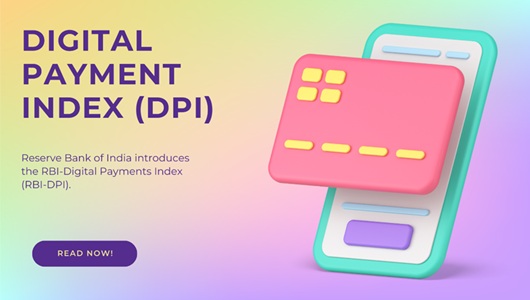(Prelims: Economic and Social Development)
(Mains, General Studies Paper-3: Topics related to Indian Economy and Planning, Mobilization of Resources, Progress, Development and Employment) |
Context
India’s digital payments system has shown phenomenal growth in recent years, reflecting the country’s rapid progress towards a digital economy. According to the recent data released by the Reserve Bank of India (RBI), the RBI Digital Payments Index (RBI-DPI) reached 493.22 in March 2025, up significantly from 465.33 in September 2024.

About Digital Payments Index
- What is it: This index was launched in January 2021 by the Reserve Bank of India to measure the spread of digital payments in the country, with March 2018 as the base period (100).
- Key parameters: It includes five key parameters-
- Payment Infrastructure (Supply Side): Availability of infrastructure required for digital payments
- Payment Performance: Volume and value of digital payments
- Payment Infrastructure (Demand Side): Consumer demand and usage
- Consumer Behavior: Consumer preference for digital payments
- Regulatory Framework: Policy and regulatory support
- Growth: It was at 153.47 in March 2019, reaching 493.22 in March 2025, showing more than four-fold increase in digital payment activity.
Key factors for the growth of digital payments
- Expansion of payment infrastructure
- Increase in merchant acceptance network has made digital payments accessible to small businesses and rural areas.
- Wide acceptance of QR code-based payments has made transactions simple and cost-effective.
- Improved availability of digital banking services has increased access in rural and semi-urban areas.
- Rise of UPI
- Unified Payments Interface (UPI) has become the backbone of digital payments in India. Its rapid growth, especially in small value transactions, has made it popular.
- The usability and ease of use of UPI has made it the preferred payment method in both urban and rural areas.
- Government initiatives
- Digital India initiative has promoted digital infrastructure and financial inclusion.
- Bank accounts linked to Aadhaar and mobile number have made digital transactions secure and easy.
- Smartphone and Internet penetration
- Increasing smartphone penetration and cheap data plans have boosted the acceptance of digital payments.
- Improved internet connectivity in rural areas has made digital payments more accessible.
- Fintech innovations
- Fintech companies have developed user-friendly apps and solutions that are boosting digital payments.
- Startups have promoted innovations such as QR codes, digital wallets and peer-to-peer payments.
|
Did you know ?
India's UPI is now the world's top (No. 1) real-time payment system. It drives 85% of all digital transactions in India and nearly 50% of global digital payments.
|